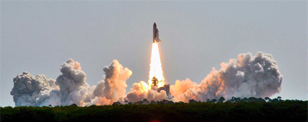 On
July 16, Discovery successfully launched on a mission to the International
Space Station, the first shuttle launch since the 2003 Columbia disaster.
Courtesy of NASA.
On
July 16, Discovery successfully launched on a mission to the International
Space Station, the first shuttle launch since the 2003 Columbia disaster.
Courtesy of NASA.
 On
July 16, Discovery successfully launched on a mission to the International
Space Station, the first shuttle launch since the 2003 Columbia disaster.
Courtesy of NASA.
On
July 16, Discovery successfully launched on a mission to the International
Space Station, the first shuttle launch since the 2003 Columbia disaster.
Courtesy of NASA.
Geotimes: What do you think the top planetary science stories
are this year?
DJS: I would say it’s been a big year, and a very important year,
and three things come to mind. One of them is a continuing story … and
that is, of course, the Mars rovers.
The Mars rovers have continued to find interesting things, and there’s
been a consolidation during the past calendar year. The evidence from both rovers
strongly suggests the role of running water on the surface of Mars in the distant
past, and this role is expressed in the rocks that are seen. Of course that
was a big discovery 18, 20 months ago, so in that sense it’s not really
a new story, but the story has been strengthened, and I think that’s very
significant.
Now, the two new stories: first is the discovery of a body in the Kuiper Belt
that’s bigger than Pluto.
Geotimes: What is the broader impact of finding that object?
DJS: Actually the broader story is that we’re developing a picture
of the Kuiper Belt, the family of bodies [located beyond Neptune], one of which
is Pluto, and now we have a whole bunch of others.
[It’s important] not to focus on the fact that a bigger one has been found,
but that we’re seeing a diversity of bodies out there.
The exciting information that I’m aware of is not yet published. The discoveries
are done by Mike Brown [of Caltech], two doors down from me, so I know what’s
going on. … It’s evident already that these objects are not all the
same; in other words, they’re not just Pluto-like. They have different
surfaces; they have different material properties. Because there are spectra
for some of these objects, it’s not just that they have been discovered:
People have collected spectra, they’ve looked at what’s on the surface
of these objects, [and] they’re not all the same.
Geotimes: And that has implications for the way the solar system
formed, right?
DJS: Yes, although exactly how to interpret that, I think, is quite mysterious
at the moment. It’s a discovery story rather than a synthesis story. We
don’t quite really know what it all means yet, but this is exciting science
— it’s at a stage where people are finding things; they aren’t
sure what it all means yet.
I also think that although it’s important to focus on the question of why
it all matters, the fact remains that [astronomers have found] the biggest object
in the solar system that orbits the sun since the discovery of Neptune, which
was in 1846 — isn’t that a good story?
Geotimes: So, what was the third thing?
DJS: The third thing would be Titan. Cassini, together with the Huygens
probe, which dropped into the atmosphere of Titan [Saturn’s largest moon]
last January, has opened up a view of a remarkable body. We now see on the surface
of Titan channels that look like rivers, plains that look as though they might
have been created through deposition of material that was carried by liquid,
and structures on the surface of Titan that some people want to attribute to
volcanism. This is an extraordinary thing, and it is a combination of the data
collected by the Huygens probe and the information collected from the spacecraft
that orbits Saturn and occasionally passes Titan every couple of months. …
And from that, there are radar pictures and also pictures in the near-infrared
that allow you to see down to the surface.
So, here is a body that from the point of view of process is a planet —
yes, it orbits Saturn, but it has planetary processes: dense atmosphere and
rainfall (the rain is methane of course). … As a consequence, it has the
climatic cycle and the geologic cycle. The materials are very different, of
course, but the processes on Titan right now have greater similarity to the
processes on Earth right now than any other planet in the solar system, including
Mars, and that’s remarkable.
Geotimes: Those are the three big things. Anything else that
you would mention?
DJS: The extrasolar planet game continues to be an enormously productive
business. The number of extrasolar planets is up to 150 [and] keeps going up.
We’re getting an increasingly better picture of what these objects are,
what their masses are, the extent to which there are multiple planet systems,
what it is that dictates whether a star will have a planet. There’s some
indication that when you have an abundance of heavy elements, you are likely
to have planets. That’s an ongoing story in the same sense that Mars is
an ongoing story.
 |
Geotimes Home | AGI Home | Information Services | Geoscience Education | Public Policy | Programs | Publications | Careers |